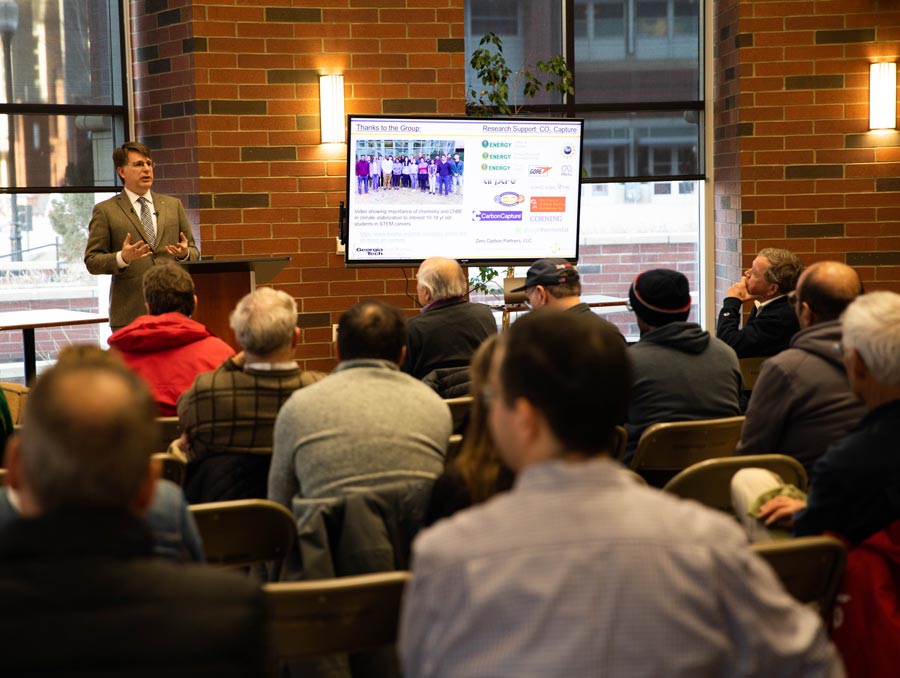On February 22, the Colleges of Science and Engineering hosted Georgia Tech Professor of Chemical Engineering Christopher Jones as the second speaker in the Energy Solutions Forum.
The Energy Solutions Forum is designed to bring scientists who are working on solutions to fight climate change to the University campus and inspire collaborations between researchers. Jones has been working on developing direct air capture, or DAC, methods to take carbon dioxide out of the atmosphere.
“We can’t just snap our fingers and immediately switch from a largely fossil-based economy that we’ve built over a hundred years to a renewable-based economy overnight, it’s just not possible,” Jones said. “So how do you balance these things effectively?”
Jones likens the atmosphere to a bathtub, saying that we are filling the bathtub with carbon dioxide. He said that to successfully decarbonize our economy and prevent the bathtub from overflowing, we need two parallel approaches. The first is continuing and speeding up the transition to renewable energy, such as geothermal or wind energy.
“We can think about that as a way of slowing the rate… at which we fill a bathtub,” Jones said.
The second approach is draining the bathtub. DAC can function as a drain to remove carbon from the atmosphere, and is one type of negative emissions technology, or NETs. Jones argues that the transition needs to minimize harm to the environment and to people. There are already natural versions of NETs, such as forests and coastal ecosystems.
“Those are pretty low-cost and they leverage natural systems, but they don’t scale to the amount of negative emissions that we need to stabilize climate,” he said. “We need to have engineered solutions that we layer on top of natural solutions so that we can get to the scale of CO2 removal necessary to stabilize the climate.”
Jones was drawn to working on DAC because it’s one of the more cutting-edge methods to reduce carbon in the atmosphere. It’s also almost infinitely scalable, once it becomes cost effective. A large part of Jones’ research is reducing the cost of DAC.
“The target that people talk about is on the order of $100/ton of CO2,” Jones said. Currently, each ton of carbon dioxide removal costs about $500.
Jones is also concerned about the life cycle assessment of the technology. Making the technology affordable is important, but ensuring that the production, deployment and retirement of the technology doesn’t require large carbon emissions is also critical.
The DAC method that Jones researchers uses amines that the carbon “sticks” to. The carbon can then be removed and stored underground, where it will mineralize. Amines-based DAC is a carbon-negative process, as long as the amines can be used for a suitable amount of time. Jones’s lab is working on stabilizing the amines so that they can last longer. He said one of the big unknowns is once the technology is scaled up, how accurate the analysis for lifetime and cost will be for the technology.
“I work with amines because they’re readily available, they have existing supply chains, they capture CO2 really well, and they work in all climates,” Jones said.
Another large challenge facing non-amine DAC is the variability in climate that naturally exists in the world. Capturing carbon out of the hot, humid air in Florida is very different from capturing carbon out of the cold, dry air in Nevada. In that way, deploying DAC technologies is similar to renewable energy, in that the technology will be adapted to the climate and natural environment.
Jones said that the largest challenge is taking the technology from the lab to deployment. Recently, he said there have been several government-funded programs that have been rolled out recently with the goal of streamlining that process, but it means that researchers will have to work more quickly.
Jones is the second in a series of speakers who will be at the University with the goal of promoting solutions-oriented climate science. The Energy Solutions Forum will continue throughout the spring semester, with the next talk by National Renewable Energy Laboratory senior scientist Joey Luther coming to campus on March 15 about improving efficiency in solar photovoltaics. Registration for the talk is open now via Eventbrite.















